Case Study: Strategic Management of Australian Supermarket Industry
VerifiedAdded on 2023/06/12
|9
|2791
|385
Case Study
AI Summary
This case study delves into the strategic management of the Australian supermarket industry, dominated by Woolworths and Coles, with Aldi emerging as a significant competitor. It employs PESTLE and Porter's Five Forces to analyze the macro environment and competitive dynamics, respectively. The analysis covers the industry's maturity stage, the bargaining power of buyers and suppliers, threats from new entrants and substitutes, and rivalry among existing firms. Company-specific strategies of Woolworths and Coles are examined, including Woolworths' focus on customer culture and sustainable sales, and Coles' emphasis on value and customer relationships. The entry of Aldi and its impact on the competitive landscape are also discussed. The report concludes with recommendations for Woolworths and Coles to enhance customer service, improve store layouts, and refine their strategies to maintain market position in the face of increasing competition. Desklib provides access to similar case studies and solved assignments for students.
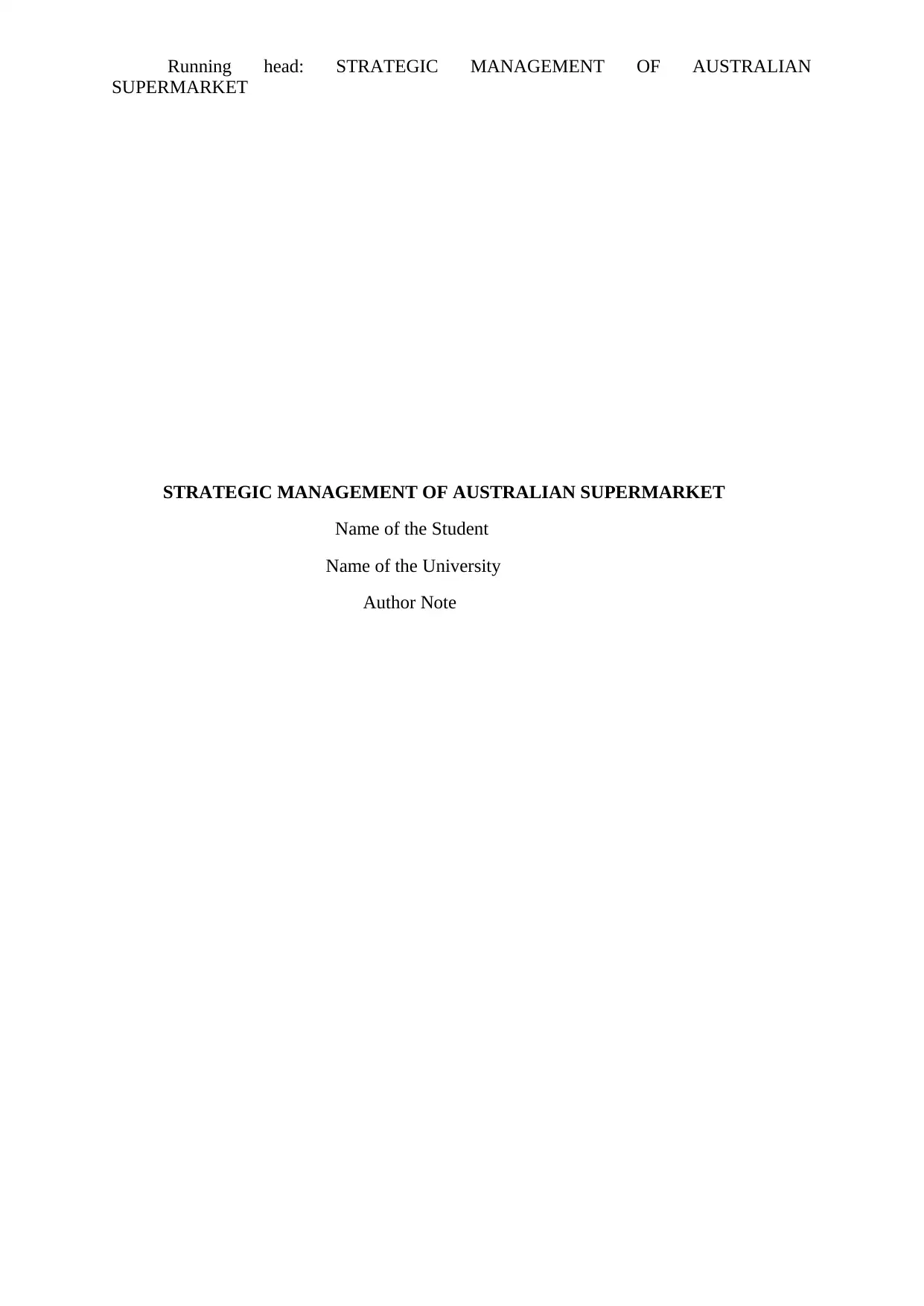
Running head: STRATEGIC MANAGEMENT OF AUSTRALIAN
SUPERMARKET
STRATEGIC MANAGEMENT OF AUSTRALIAN SUPERMARKET
Name of the Student
Name of the University
Author Note
SUPERMARKET
STRATEGIC MANAGEMENT OF AUSTRALIAN SUPERMARKET
Name of the Student
Name of the University
Author Note
Paraphrase This Document
Need a fresh take? Get an instant paraphrase of this document with our AI Paraphraser
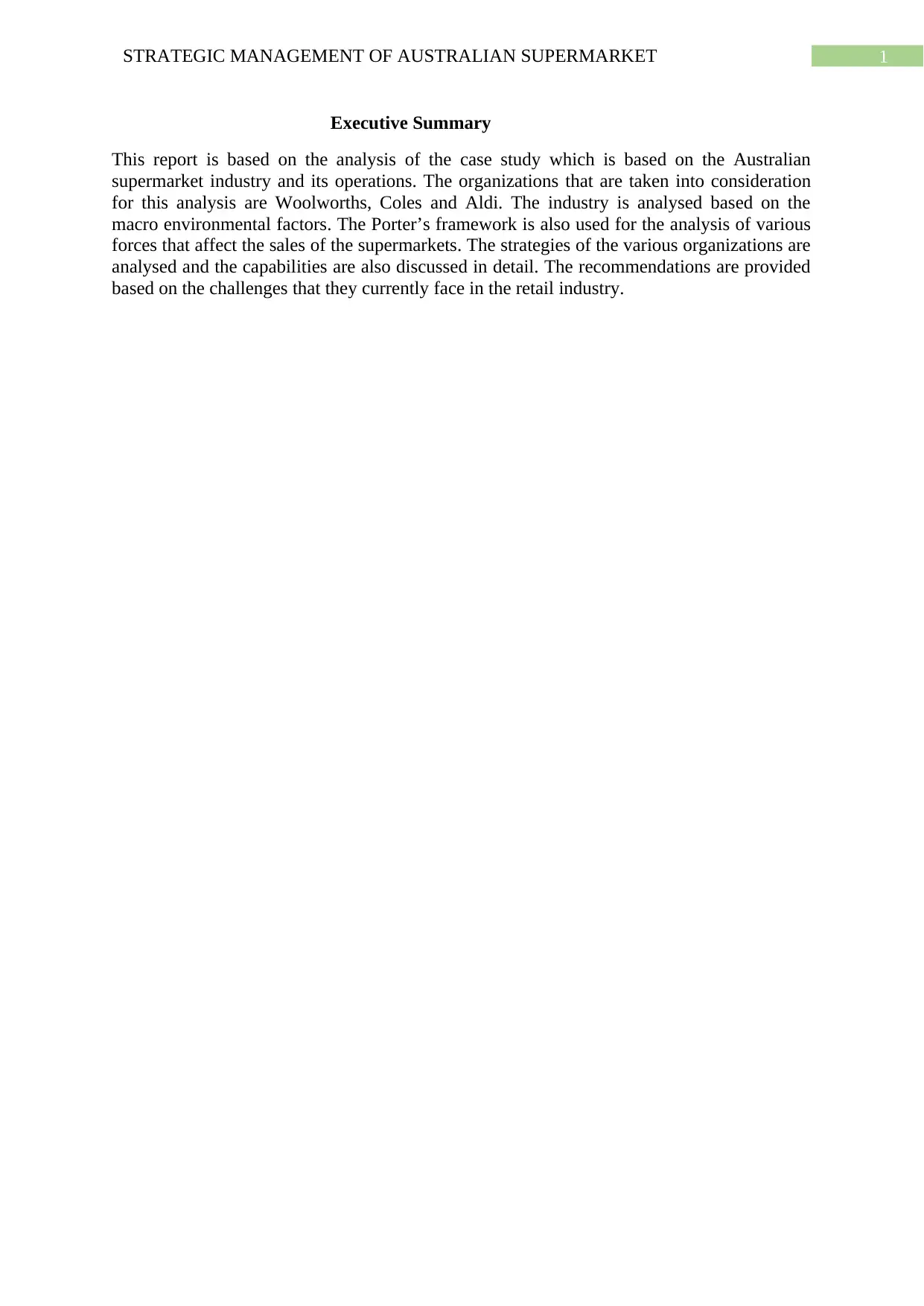
1STRATEGIC MANAGEMENT OF AUSTRALIAN SUPERMARKET
Executive Summary
This report is based on the analysis of the case study which is based on the Australian
supermarket industry and its operations. The organizations that are taken into consideration
for this analysis are Woolworths, Coles and Aldi. The industry is analysed based on the
macro environmental factors. The Porter’s framework is also used for the analysis of various
forces that affect the sales of the supermarkets. The strategies of the various organizations are
analysed and the capabilities are also discussed in detail. The recommendations are provided
based on the challenges that they currently face in the retail industry.
Executive Summary
This report is based on the analysis of the case study which is based on the Australian
supermarket industry and its operations. The organizations that are taken into consideration
for this analysis are Woolworths, Coles and Aldi. The industry is analysed based on the
macro environmental factors. The Porter’s framework is also used for the analysis of various
forces that affect the sales of the supermarkets. The strategies of the various organizations are
analysed and the capabilities are also discussed in detail. The recommendations are provided
based on the challenges that they currently face in the retail industry.
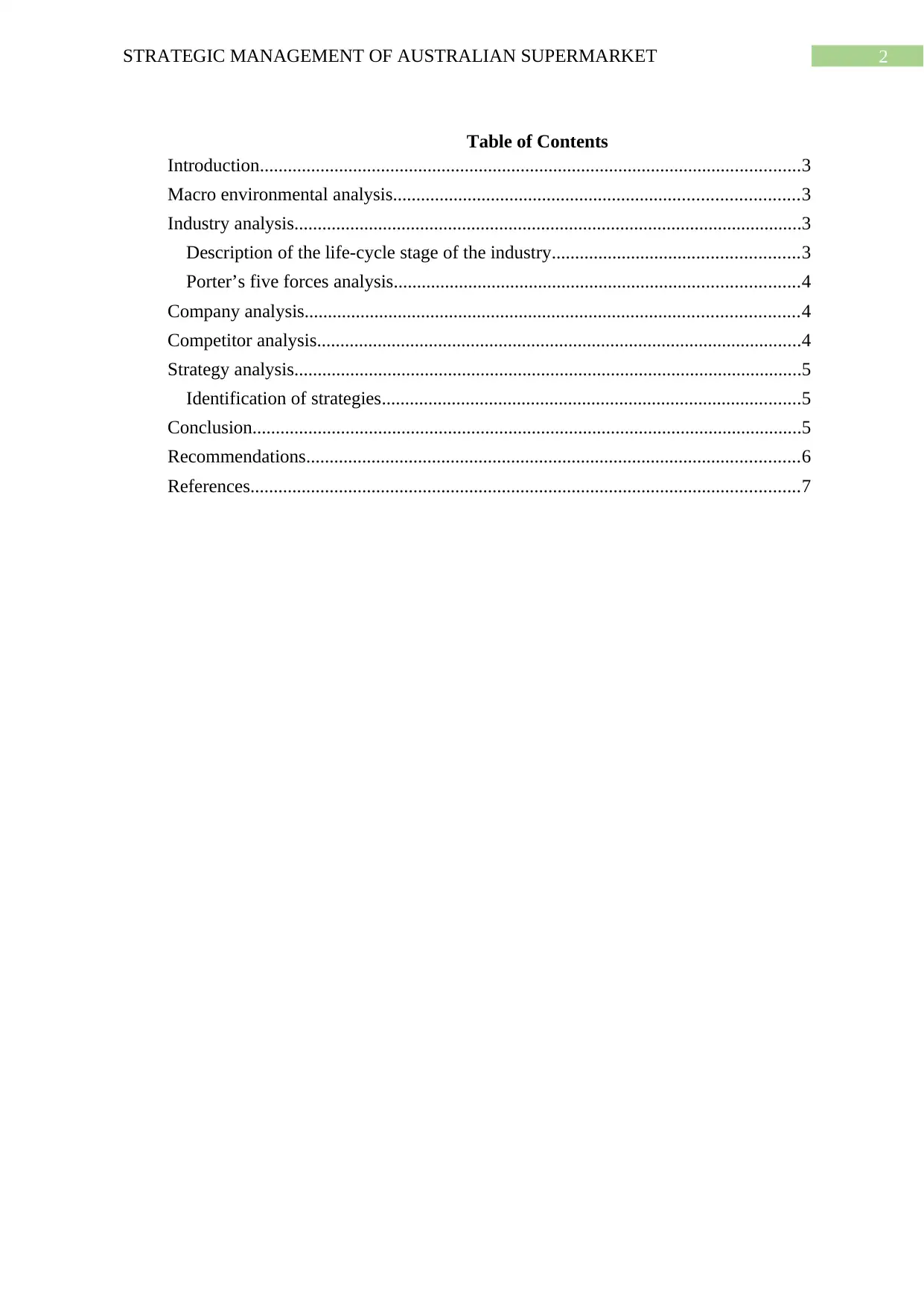
2STRATEGIC MANAGEMENT OF AUSTRALIAN SUPERMARKET
Table of Contents
Introduction....................................................................................................................3
Macro environmental analysis.......................................................................................3
Industry analysis.............................................................................................................3
Description of the life-cycle stage of the industry.....................................................3
Porter’s five forces analysis.......................................................................................4
Company analysis..........................................................................................................4
Competitor analysis........................................................................................................4
Strategy analysis.............................................................................................................5
Identification of strategies..........................................................................................5
Conclusion......................................................................................................................5
Recommendations..........................................................................................................6
References......................................................................................................................7
Table of Contents
Introduction....................................................................................................................3
Macro environmental analysis.......................................................................................3
Industry analysis.............................................................................................................3
Description of the life-cycle stage of the industry.....................................................3
Porter’s five forces analysis.......................................................................................4
Company analysis..........................................................................................................4
Competitor analysis........................................................................................................4
Strategy analysis.............................................................................................................5
Identification of strategies..........................................................................................5
Conclusion......................................................................................................................5
Recommendations..........................................................................................................6
References......................................................................................................................7
⊘ This is a preview!⊘
Do you want full access?
Subscribe today to unlock all pages.

Trusted by 1+ million students worldwide
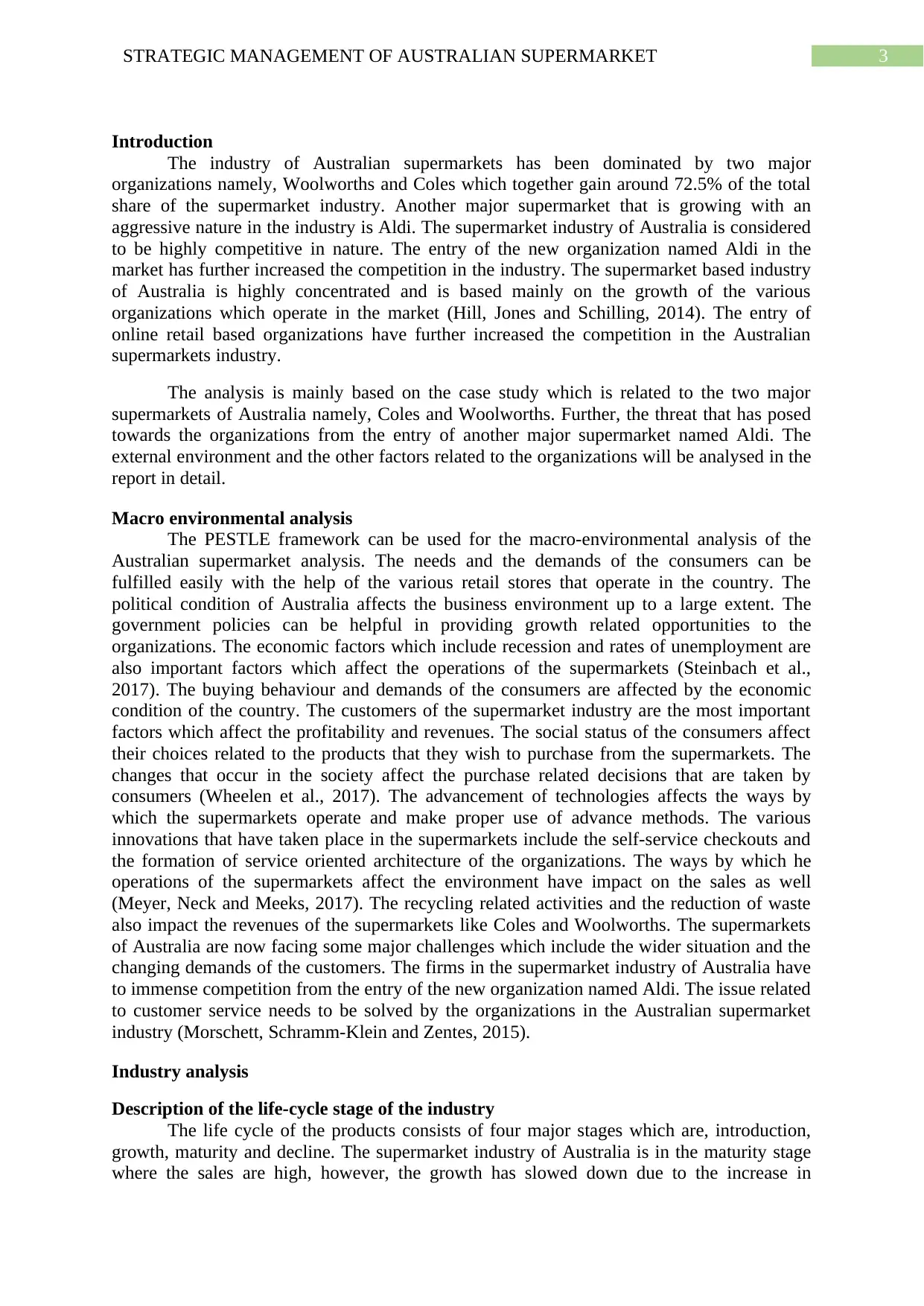
3STRATEGIC MANAGEMENT OF AUSTRALIAN SUPERMARKET
Introduction
The industry of Australian supermarkets has been dominated by two major
organizations namely, Woolworths and Coles which together gain around 72.5% of the total
share of the supermarket industry. Another major supermarket that is growing with an
aggressive nature in the industry is Aldi. The supermarket industry of Australia is considered
to be highly competitive in nature. The entry of the new organization named Aldi in the
market has further increased the competition in the industry. The supermarket based industry
of Australia is highly concentrated and is based mainly on the growth of the various
organizations which operate in the market (Hill, Jones and Schilling, 2014). The entry of
online retail based organizations have further increased the competition in the Australian
supermarkets industry.
The analysis is mainly based on the case study which is related to the two major
supermarkets of Australia namely, Coles and Woolworths. Further, the threat that has posed
towards the organizations from the entry of another major supermarket named Aldi. The
external environment and the other factors related to the organizations will be analysed in the
report in detail.
Macro environmental analysis
The PESTLE framework can be used for the macro-environmental analysis of the
Australian supermarket analysis. The needs and the demands of the consumers can be
fulfilled easily with the help of the various retail stores that operate in the country. The
political condition of Australia affects the business environment up to a large extent. The
government policies can be helpful in providing growth related opportunities to the
organizations. The economic factors which include recession and rates of unemployment are
also important factors which affect the operations of the supermarkets (Steinbach et al.,
2017). The buying behaviour and demands of the consumers are affected by the economic
condition of the country. The customers of the supermarket industry are the most important
factors which affect the profitability and revenues. The social status of the consumers affect
their choices related to the products that they wish to purchase from the supermarkets. The
changes that occur in the society affect the purchase related decisions that are taken by
consumers (Wheelen et al., 2017). The advancement of technologies affects the ways by
which the supermarkets operate and make proper use of advance methods. The various
innovations that have taken place in the supermarkets include the self-service checkouts and
the formation of service oriented architecture of the organizations. The ways by which he
operations of the supermarkets affect the environment have impact on the sales as well
(Meyer, Neck and Meeks, 2017). The recycling related activities and the reduction of waste
also impact the revenues of the supermarkets like Coles and Woolworths. The supermarkets
of Australia are now facing some major challenges which include the wider situation and the
changing demands of the customers. The firms in the supermarket industry of Australia have
to immense competition from the entry of the new organization named Aldi. The issue related
to customer service needs to be solved by the organizations in the Australian supermarket
industry (Morschett, Schramm-Klein and Zentes, 2015).
Industry analysis
Description of the life-cycle stage of the industry
The life cycle of the products consists of four major stages which are, introduction,
growth, maturity and decline. The supermarket industry of Australia is in the maturity stage
where the sales are high, however, the growth has slowed down due to the increase in
Introduction
The industry of Australian supermarkets has been dominated by two major
organizations namely, Woolworths and Coles which together gain around 72.5% of the total
share of the supermarket industry. Another major supermarket that is growing with an
aggressive nature in the industry is Aldi. The supermarket industry of Australia is considered
to be highly competitive in nature. The entry of the new organization named Aldi in the
market has further increased the competition in the industry. The supermarket based industry
of Australia is highly concentrated and is based mainly on the growth of the various
organizations which operate in the market (Hill, Jones and Schilling, 2014). The entry of
online retail based organizations have further increased the competition in the Australian
supermarkets industry.
The analysis is mainly based on the case study which is related to the two major
supermarkets of Australia namely, Coles and Woolworths. Further, the threat that has posed
towards the organizations from the entry of another major supermarket named Aldi. The
external environment and the other factors related to the organizations will be analysed in the
report in detail.
Macro environmental analysis
The PESTLE framework can be used for the macro-environmental analysis of the
Australian supermarket analysis. The needs and the demands of the consumers can be
fulfilled easily with the help of the various retail stores that operate in the country. The
political condition of Australia affects the business environment up to a large extent. The
government policies can be helpful in providing growth related opportunities to the
organizations. The economic factors which include recession and rates of unemployment are
also important factors which affect the operations of the supermarkets (Steinbach et al.,
2017). The buying behaviour and demands of the consumers are affected by the economic
condition of the country. The customers of the supermarket industry are the most important
factors which affect the profitability and revenues. The social status of the consumers affect
their choices related to the products that they wish to purchase from the supermarkets. The
changes that occur in the society affect the purchase related decisions that are taken by
consumers (Wheelen et al., 2017). The advancement of technologies affects the ways by
which the supermarkets operate and make proper use of advance methods. The various
innovations that have taken place in the supermarkets include the self-service checkouts and
the formation of service oriented architecture of the organizations. The ways by which he
operations of the supermarkets affect the environment have impact on the sales as well
(Meyer, Neck and Meeks, 2017). The recycling related activities and the reduction of waste
also impact the revenues of the supermarkets like Coles and Woolworths. The supermarkets
of Australia are now facing some major challenges which include the wider situation and the
changing demands of the customers. The firms in the supermarket industry of Australia have
to immense competition from the entry of the new organization named Aldi. The issue related
to customer service needs to be solved by the organizations in the Australian supermarket
industry (Morschett, Schramm-Klein and Zentes, 2015).
Industry analysis
Description of the life-cycle stage of the industry
The life cycle of the products consists of four major stages which are, introduction,
growth, maturity and decline. The supermarket industry of Australia is in the maturity stage
where the sales are high, however, the growth has slowed down due to the increase in
Paraphrase This Document
Need a fresh take? Get an instant paraphrase of this document with our AI Paraphraser

4STRATEGIC MANAGEMENT OF AUSTRALIAN SUPERMARKET
competition in the market. The organizations thereby need to take steps to increase their
growth so that they do not reach the decline stage (Trigeorgis and Reuer, 2017).
Porter’s five forces analysis
Bargaining related power of the buyers – The power of the buyers related to
bargaining is high in the Australian retail industry. This force has become more powerful due
to the increase in the number of supermarkets in Australia. The consumers have many options
to select from and this has also increased the power of buyers.
Bargaining related power of the suppliers – The bargaining related power of the
suppliers is moderate in the Australian supermarket industry. The high concentration of
organizations in the industry which further includes some big players have kept the power of
the suppliers to a lower level (Brewster, 2017).
Threats related to the new entrants – The entry of new players in the Australian
retail industry has been made tough by the big players in the market. This thereby reduces the
threat that is posed by the entry of new organizations in the Australian super market.
Rivalry among the existing firms – The threats related to rivalry among the
organizations in the Australian supermarket industry is high. The major players in the
supermarket industry like, Woolworths, Coles, Asda and Wesfarmers is high as they are
continuously competing with each other for larger share in the market (Helfat and Martin,
2015).
Threats related to the substitutes – The retail products that are offered in the
supermarkets in Australia is high in demand. These products are used by the consumers on a
daily basis and they are loyal to the supermarkets. This decreases the threat related to
substitutes in the Australian supermarket industry (Schnackenberg and Tomlinson, 2016).
Company analysis
The organizations which have been dominating the Australian supermarket industry
are, Woolworths and Coles. Woolworths is considered to be the biggest chain supermarkets
in Australia. The operations of Woolworths lie on the huge team of 115,000 employees with
more than 900 stores all over Australia. The major goal of Woolworths has been to supply the
fresh products direct to the consumers. Coles on the other hand is another consumer and retail
chain which has its operations in Australia. The company is now running its operations in
Australia under its parent organization. Wesfarmers which is a large conglomerate in
Australia. The Australian supermarket industry has seen huge competition among the two
largest players who have been trying to constantly improve the operations of the company
and increase their customer base (Woolworths.com.au., 2018). These two large organizations
are now being challenged by the entry of Aldi in the Australian market. Woolworths has
become largest retailer in Australia after facing tough competition from the operations and
profitability of Coles. The organization is a part of Wesfarmers which is a large conglomerate
in Australia. Coles also has its operations in many other businesses which include, Bunning,
which is a retailer of household products, Officeworks, Kmart and many more. Woolworths
outperformed the profitability of Coles in the industry and this situation changed when the
company was acquired by Wesfarmers (Coles.com.au., 2018).
Competitor analysis
The levels of competition are quite high between the two organizations, namely,
Coles and Woolworths. The competition among these two organizations has often turned
hostile. The strategy that had been implemented by the firms related to their pricing related
competition in the market. The organizations thereby need to take steps to increase their
growth so that they do not reach the decline stage (Trigeorgis and Reuer, 2017).
Porter’s five forces analysis
Bargaining related power of the buyers – The power of the buyers related to
bargaining is high in the Australian retail industry. This force has become more powerful due
to the increase in the number of supermarkets in Australia. The consumers have many options
to select from and this has also increased the power of buyers.
Bargaining related power of the suppliers – The bargaining related power of the
suppliers is moderate in the Australian supermarket industry. The high concentration of
organizations in the industry which further includes some big players have kept the power of
the suppliers to a lower level (Brewster, 2017).
Threats related to the new entrants – The entry of new players in the Australian
retail industry has been made tough by the big players in the market. This thereby reduces the
threat that is posed by the entry of new organizations in the Australian super market.
Rivalry among the existing firms – The threats related to rivalry among the
organizations in the Australian supermarket industry is high. The major players in the
supermarket industry like, Woolworths, Coles, Asda and Wesfarmers is high as they are
continuously competing with each other for larger share in the market (Helfat and Martin,
2015).
Threats related to the substitutes – The retail products that are offered in the
supermarkets in Australia is high in demand. These products are used by the consumers on a
daily basis and they are loyal to the supermarkets. This decreases the threat related to
substitutes in the Australian supermarket industry (Schnackenberg and Tomlinson, 2016).
Company analysis
The organizations which have been dominating the Australian supermarket industry
are, Woolworths and Coles. Woolworths is considered to be the biggest chain supermarkets
in Australia. The operations of Woolworths lie on the huge team of 115,000 employees with
more than 900 stores all over Australia. The major goal of Woolworths has been to supply the
fresh products direct to the consumers. Coles on the other hand is another consumer and retail
chain which has its operations in Australia. The company is now running its operations in
Australia under its parent organization. Wesfarmers which is a large conglomerate in
Australia. The Australian supermarket industry has seen huge competition among the two
largest players who have been trying to constantly improve the operations of the company
and increase their customer base (Woolworths.com.au., 2018). These two large organizations
are now being challenged by the entry of Aldi in the Australian market. Woolworths has
become largest retailer in Australia after facing tough competition from the operations and
profitability of Coles. The organization is a part of Wesfarmers which is a large conglomerate
in Australia. Coles also has its operations in many other businesses which include, Bunning,
which is a retailer of household products, Officeworks, Kmart and many more. Woolworths
outperformed the profitability of Coles in the industry and this situation changed when the
company was acquired by Wesfarmers (Coles.com.au., 2018).
Competitor analysis
The levels of competition are quite high between the two organizations, namely,
Coles and Woolworths. The competition among these two organizations has often turned
hostile. The strategy that had been implemented by the firms related to their pricing related
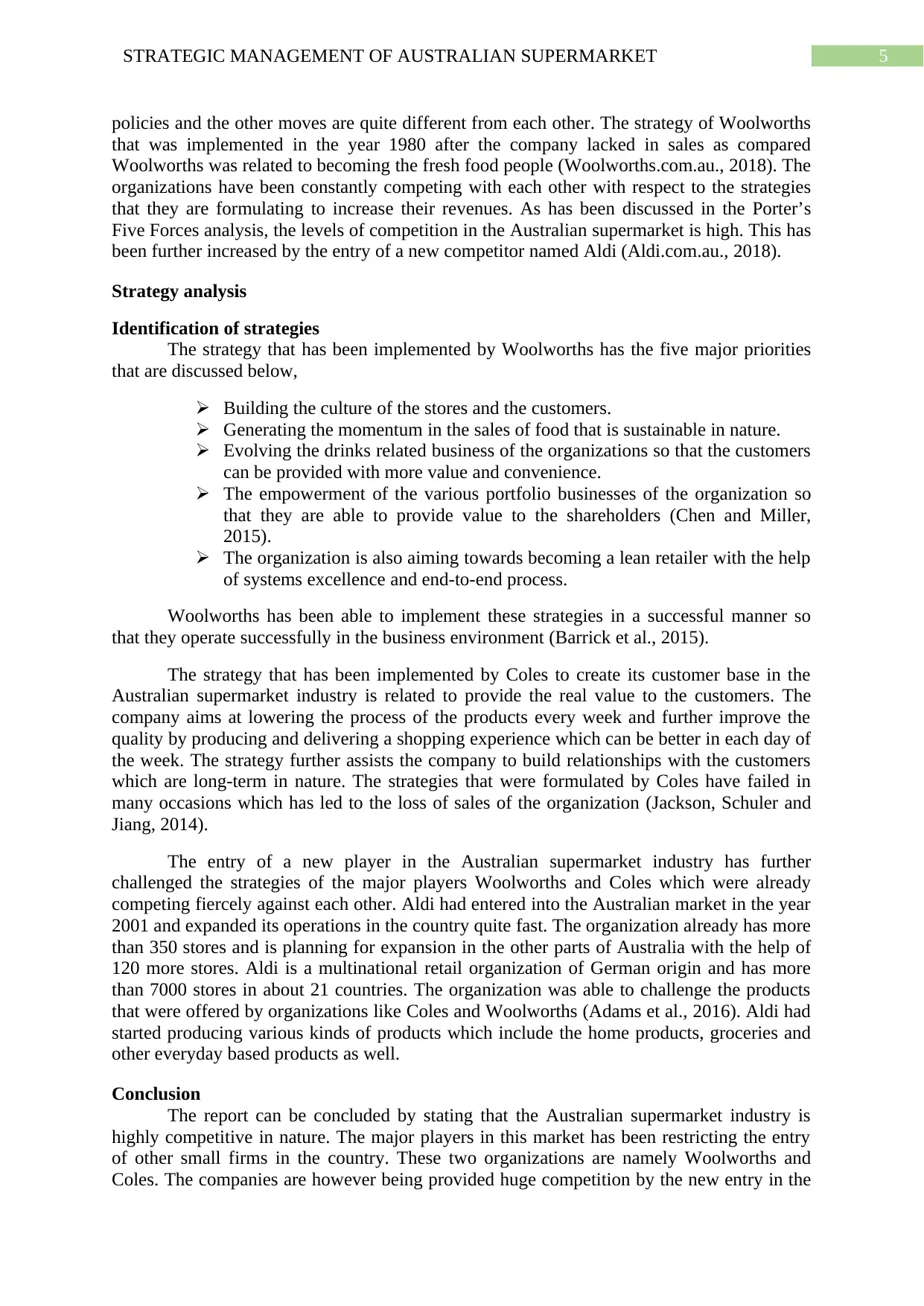
5STRATEGIC MANAGEMENT OF AUSTRALIAN SUPERMARKET
policies and the other moves are quite different from each other. The strategy of Woolworths
that was implemented in the year 1980 after the company lacked in sales as compared
Woolworths was related to becoming the fresh food people (Woolworths.com.au., 2018). The
organizations have been constantly competing with each other with respect to the strategies
that they are formulating to increase their revenues. As has been discussed in the Porter’s
Five Forces analysis, the levels of competition in the Australian supermarket is high. This has
been further increased by the entry of a new competitor named Aldi (Aldi.com.au., 2018).
Strategy analysis
Identification of strategies
The strategy that has been implemented by Woolworths has the five major priorities
that are discussed below,
Building the culture of the stores and the customers.
Generating the momentum in the sales of food that is sustainable in nature.
Evolving the drinks related business of the organizations so that the customers
can be provided with more value and convenience.
The empowerment of the various portfolio businesses of the organization so
that they are able to provide value to the shareholders (Chen and Miller,
2015).
The organization is also aiming towards becoming a lean retailer with the help
of systems excellence and end-to-end process.
Woolworths has been able to implement these strategies in a successful manner so
that they operate successfully in the business environment (Barrick et al., 2015).
The strategy that has been implemented by Coles to create its customer base in the
Australian supermarket industry is related to provide the real value to the customers. The
company aims at lowering the process of the products every week and further improve the
quality by producing and delivering a shopping experience which can be better in each day of
the week. The strategy further assists the company to build relationships with the customers
which are long-term in nature. The strategies that were formulated by Coles have failed in
many occasions which has led to the loss of sales of the organization (Jackson, Schuler and
Jiang, 2014).
The entry of a new player in the Australian supermarket industry has further
challenged the strategies of the major players Woolworths and Coles which were already
competing fiercely against each other. Aldi had entered into the Australian market in the year
2001 and expanded its operations in the country quite fast. The organization already has more
than 350 stores and is planning for expansion in the other parts of Australia with the help of
120 more stores. Aldi is a multinational retail organization of German origin and has more
than 7000 stores in about 21 countries. The organization was able to challenge the products
that were offered by organizations like Coles and Woolworths (Adams et al., 2016). Aldi had
started producing various kinds of products which include the home products, groceries and
other everyday based products as well.
Conclusion
The report can be concluded by stating that the Australian supermarket industry is
highly competitive in nature. The major players in this market has been restricting the entry
of other small firms in the country. These two organizations are namely Woolworths and
Coles. The companies are however being provided huge competition by the new entry in the
policies and the other moves are quite different from each other. The strategy of Woolworths
that was implemented in the year 1980 after the company lacked in sales as compared
Woolworths was related to becoming the fresh food people (Woolworths.com.au., 2018). The
organizations have been constantly competing with each other with respect to the strategies
that they are formulating to increase their revenues. As has been discussed in the Porter’s
Five Forces analysis, the levels of competition in the Australian supermarket is high. This has
been further increased by the entry of a new competitor named Aldi (Aldi.com.au., 2018).
Strategy analysis
Identification of strategies
The strategy that has been implemented by Woolworths has the five major priorities
that are discussed below,
Building the culture of the stores and the customers.
Generating the momentum in the sales of food that is sustainable in nature.
Evolving the drinks related business of the organizations so that the customers
can be provided with more value and convenience.
The empowerment of the various portfolio businesses of the organization so
that they are able to provide value to the shareholders (Chen and Miller,
2015).
The organization is also aiming towards becoming a lean retailer with the help
of systems excellence and end-to-end process.
Woolworths has been able to implement these strategies in a successful manner so
that they operate successfully in the business environment (Barrick et al., 2015).
The strategy that has been implemented by Coles to create its customer base in the
Australian supermarket industry is related to provide the real value to the customers. The
company aims at lowering the process of the products every week and further improve the
quality by producing and delivering a shopping experience which can be better in each day of
the week. The strategy further assists the company to build relationships with the customers
which are long-term in nature. The strategies that were formulated by Coles have failed in
many occasions which has led to the loss of sales of the organization (Jackson, Schuler and
Jiang, 2014).
The entry of a new player in the Australian supermarket industry has further
challenged the strategies of the major players Woolworths and Coles which were already
competing fiercely against each other. Aldi had entered into the Australian market in the year
2001 and expanded its operations in the country quite fast. The organization already has more
than 350 stores and is planning for expansion in the other parts of Australia with the help of
120 more stores. Aldi is a multinational retail organization of German origin and has more
than 7000 stores in about 21 countries. The organization was able to challenge the products
that were offered by organizations like Coles and Woolworths (Adams et al., 2016). Aldi had
started producing various kinds of products which include the home products, groceries and
other everyday based products as well.
Conclusion
The report can be concluded by stating that the Australian supermarket industry is
highly competitive in nature. The major players in this market has been restricting the entry
of other small firms in the country. These two organizations are namely Woolworths and
Coles. The companies are however being provided huge competition by the new entry in the
⊘ This is a preview!⊘
Do you want full access?
Subscribe today to unlock all pages.

Trusted by 1+ million students worldwide

6STRATEGIC MANAGEMENT OF AUSTRALIAN SUPERMARKET
industry named Aldi. The competition in the market has become much more intense on
nature and This has affected the revenues of the major retail organizations in the country. The
challenges that are being faced by the organizations thereby need to be addressed so that the
revenues and market position of Woolworths and Coles can be maintained.
Recommendations
Woolworths and Coles need to formulate strategies that are effective in nature.
The two organizations need to improve their customer service related
operations so that the customer base can be increased and the loyal customers
can be maintained as well.
The style of the stores of both the companies need to be improved so that it is
convenient for the customers.
Woolworths has been using the strategy related to the focus that is placed on
the preferences of the specific customers. This has enabled the company to
understand the needs of the consumers. This strategy can also be implemented
by the other organizations in the Australian supermarket industry.
The retail organizations also need to implement the e-commerce related
strategies to compete with the online retailers like Amazon.
industry named Aldi. The competition in the market has become much more intense on
nature and This has affected the revenues of the major retail organizations in the country. The
challenges that are being faced by the organizations thereby need to be addressed so that the
revenues and market position of Woolworths and Coles can be maintained.
Recommendations
Woolworths and Coles need to formulate strategies that are effective in nature.
The two organizations need to improve their customer service related
operations so that the customer base can be increased and the loyal customers
can be maintained as well.
The style of the stores of both the companies need to be improved so that it is
convenient for the customers.
Woolworths has been using the strategy related to the focus that is placed on
the preferences of the specific customers. This has enabled the company to
understand the needs of the consumers. This strategy can also be implemented
by the other organizations in the Australian supermarket industry.
The retail organizations also need to implement the e-commerce related
strategies to compete with the online retailers like Amazon.
Paraphrase This Document
Need a fresh take? Get an instant paraphrase of this document with our AI Paraphraser

7STRATEGIC MANAGEMENT OF AUSTRALIAN SUPERMARKET
References
Adams, R., Jeanrenaud, S., Bessant, J., Denyer, D. and Overy, P., 2016. Sustainability‐
oriented innovation: a systematic review. International Journal of Management
Reviews, 18(2), pp.180-205.
Aldi.com.au. (2018). ALDI Supermarkets - Good Different - ALDI Australia. [online]
Available at: https://www.aldi.com.au/ [Accessed 20 Apr. 2018].
Barrick, M.R., Thurgood, G.R., Smith, T.A. and Courtright, S.H., 2015. Collective
organizational engagement: Linking motivational antecedents, strategic implementation, and
firm performance. Academy of Management journal, 58(1), pp.111-135.
Brewster, C., 2017. The integration of human resource management and corporate strategy.
In Policy and practice in European human resource management (pp. 22-35). Routledge.
Chen, M.J. and Miller, D., 2015. Reconceptualizing competitive dynamics: A
multidimensional framework. Strategic Management Journal, 36(5), pp.758-775.
Coles.com.au. (2018). Coles Supermarkets. [online] Available at: https://www.coles.com.au/
[Accessed 20 Apr. 2018].
Helfat, C.E. and Martin, J.A., 2015. Dynamic managerial capabilities: Review and
assessment of managerial impact on strategic change. Journal of Management, 41(5),
pp.1281-1312.
Hill, C.W., Jones, G.R. and Schilling, M.A., 2014. Strategic management: theory: an
integrated approach. Cengage Learning.
Jackson, S.E., Schuler, R.S. and Jiang, K., 2014. An aspirational framework for strategic
human resource management. The Academy of Management Annals, 8(1), pp.1-56.
Meyer, G.D., Neck, H.M. and Meeks, M.D., 2017. The entrepreneurship‐strategic
management interface. Strategic entrepreneurship: Creating a new mindset, pp.17-44.
Morschett, D., Schramm-Klein, H. and Zentes, J., 2015. Strategic international
management (pp. 978-3658078836). Springer.
Schnackenberg, A.K. and Tomlinson, E.C., 2016. Organizational transparency: A new
perspective on managing trust in organization-stakeholder relationships. Journal of
Management, 42(7), pp.1784-1810.
Steinbach, A.L., Holcomb, T.R., Holmes, R.M., Devers, C.E. and Cannella, A.A., 2017. Top
management team incentive heterogeneity, strategic investment behavior, and performance:
A contingency theory of incentive alignment. Strategic Management Journal, 38(8), pp.1701-
1720.
Trigeorgis, L. and Reuer, J.J., 2017. Real options theory in strategic management. Strategic
Management Journal, 38(1), pp.42-63.
Wheelen, T.L., Hunger, J.D., Hoffman, A.N. and Bamford, C.E., 2017. Strategic
management and business policy. pearson.
References
Adams, R., Jeanrenaud, S., Bessant, J., Denyer, D. and Overy, P., 2016. Sustainability‐
oriented innovation: a systematic review. International Journal of Management
Reviews, 18(2), pp.180-205.
Aldi.com.au. (2018). ALDI Supermarkets - Good Different - ALDI Australia. [online]
Available at: https://www.aldi.com.au/ [Accessed 20 Apr. 2018].
Barrick, M.R., Thurgood, G.R., Smith, T.A. and Courtright, S.H., 2015. Collective
organizational engagement: Linking motivational antecedents, strategic implementation, and
firm performance. Academy of Management journal, 58(1), pp.111-135.
Brewster, C., 2017. The integration of human resource management and corporate strategy.
In Policy and practice in European human resource management (pp. 22-35). Routledge.
Chen, M.J. and Miller, D., 2015. Reconceptualizing competitive dynamics: A
multidimensional framework. Strategic Management Journal, 36(5), pp.758-775.
Coles.com.au. (2018). Coles Supermarkets. [online] Available at: https://www.coles.com.au/
[Accessed 20 Apr. 2018].
Helfat, C.E. and Martin, J.A., 2015. Dynamic managerial capabilities: Review and
assessment of managerial impact on strategic change. Journal of Management, 41(5),
pp.1281-1312.
Hill, C.W., Jones, G.R. and Schilling, M.A., 2014. Strategic management: theory: an
integrated approach. Cengage Learning.
Jackson, S.E., Schuler, R.S. and Jiang, K., 2014. An aspirational framework for strategic
human resource management. The Academy of Management Annals, 8(1), pp.1-56.
Meyer, G.D., Neck, H.M. and Meeks, M.D., 2017. The entrepreneurship‐strategic
management interface. Strategic entrepreneurship: Creating a new mindset, pp.17-44.
Morschett, D., Schramm-Klein, H. and Zentes, J., 2015. Strategic international
management (pp. 978-3658078836). Springer.
Schnackenberg, A.K. and Tomlinson, E.C., 2016. Organizational transparency: A new
perspective on managing trust in organization-stakeholder relationships. Journal of
Management, 42(7), pp.1784-1810.
Steinbach, A.L., Holcomb, T.R., Holmes, R.M., Devers, C.E. and Cannella, A.A., 2017. Top
management team incentive heterogeneity, strategic investment behavior, and performance:
A contingency theory of incentive alignment. Strategic Management Journal, 38(8), pp.1701-
1720.
Trigeorgis, L. and Reuer, J.J., 2017. Real options theory in strategic management. Strategic
Management Journal, 38(1), pp.42-63.
Wheelen, T.L., Hunger, J.D., Hoffman, A.N. and Bamford, C.E., 2017. Strategic
management and business policy. pearson.
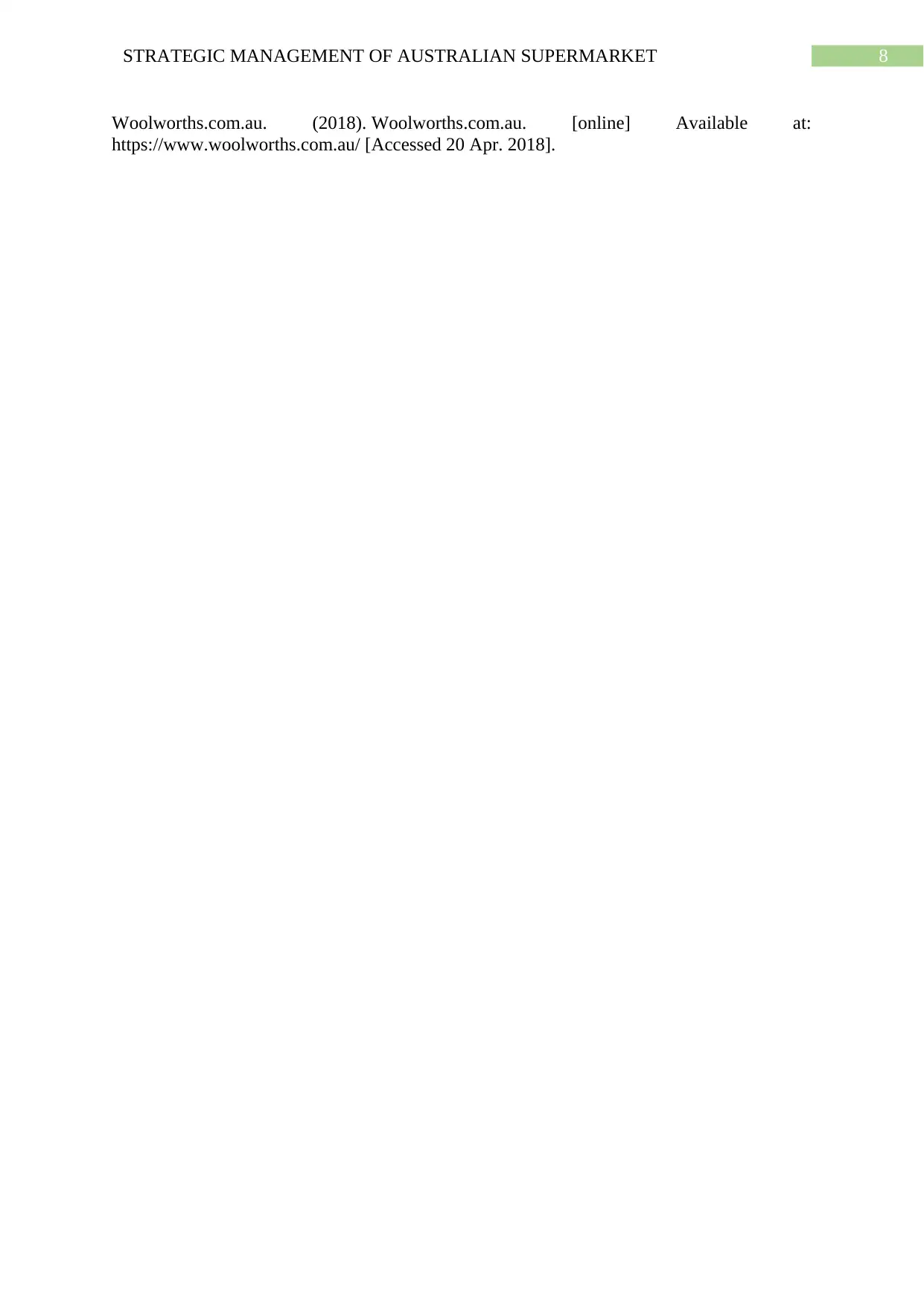
8STRATEGIC MANAGEMENT OF AUSTRALIAN SUPERMARKET
Woolworths.com.au. (2018). Woolworths.com.au. [online] Available at:
https://www.woolworths.com.au/ [Accessed 20 Apr. 2018].
Woolworths.com.au. (2018). Woolworths.com.au. [online] Available at:
https://www.woolworths.com.au/ [Accessed 20 Apr. 2018].
⊘ This is a preview!⊘
Do you want full access?
Subscribe today to unlock all pages.

Trusted by 1+ million students worldwide
1 out of 9
Related Documents
Your All-in-One AI-Powered Toolkit for Academic Success.
+13062052269
info@desklib.com
Available 24*7 on WhatsApp / Email
![[object Object]](/_next/static/media/star-bottom.7253800d.svg)
Unlock your academic potential
Copyright © 2020–2025 A2Z Services. All Rights Reserved. Developed and managed by ZUCOL.


